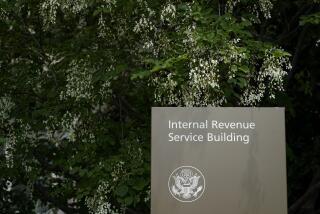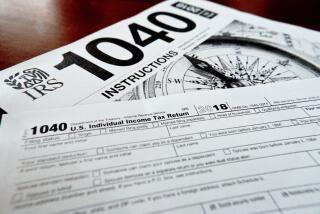VIEWPOINTS : Wealthy <i> Are</i> Doing Their Share to Satisfy Uncle Sam’s Appetite
- Share via
Each year in March or early April, about 100 million tax returns are dropped into mailboxes for delivery to the Internal Revenue Service. Altogether, these returns report gross income (technically, adjusted gross income) of about $2 trillion.
Looking at the whole picture, we risk drowning in the huge numbers. But perhaps we can gain considerable understanding by looking at averages.
The average income per tax return in 1982, for example--the most recent year for which complete IRS statistics are available--is about $20,000, and the average tax paid is about $3,000, or 15% of income. But we need more--a sense of how income and tax are apportioned among rich and poor.
So let’s take a millionth slice across the board. Put all tax returns in order by gross income, and pick one of every million. The result is shown on the accompanying chart.
First the number of people who earn at each income level. Actually, it is the number of the tax returns, not people. The majority of returns of less than $15,000 are single people and the majority of those of more than $20,000 are joint returns filed by married couples.
Of those earning $10,000 and less, about half are young folks working part time in grocery stores and restaurants while going to school. Others are probably unskilled workers.
Most of those earning $10,000 to $20,000 are semi-skilled workers. Earnings of $20,000 to $30,000 represent skilled workers, school teachers, junior executives and junior-level professors.
At $30,000 to $50,000 are middle-level executives and more senior professors. Two individuals (actually two tax returns) earn $75,000 each and one earns $200,000. These might represent the local doctor, a highly successful engineer or lawyer and a senior corporate executive.
Less Than 1% in Bracket
But, you ask, how about Gordon Getty who earns about $70 million a year, according to a recent magazine article? And all the folks who drive big cars and have big homes on hills? Those who wheel and deal on Wall Street? The million-dollar executives of giant corporations?
The answer is that they are all there, statistically speaking. Less than 1% of all Americans earn more than $100,000, and the average of their incomes is about $200,000.
Are these 100 taxpaying citizens (or couples) paying a “fair” tax? It depends on your definition. “Fair” is a little like “beauty”--it’s mostly in the eye of the beholder. But we can note that going up the income scale, both average rate and marginal rate steadily move higher.
A broad definition of “fairness” is that the marginal rate either stays level or rises with income. Taxation in this community meets that test. The marginal rates rise from 14% to 50%.
The higher-income folks pay 50% of each extra dollar earned, but their average rate peaks at a lesser 33%. This is because lower “layers” of their income are taxed at lower rates. It averages out at 33%.
Should the rich pay more? Perhaps, but there may be some reasons not to take too much away from those half-dozen top earners.
For example, the doctor might decide to take a day or two off a week for golf or to “manage his investments” and might not be available as much to treat people and perform operations.
And taxes might influence the senior business leaders when facing expansion opportunities at the local factory. If the headaches outweigh the after-tax pay, they may make decisions that will not add needed jobs in the community.
So look over the list carefully. Suppose you were a member of this community’s “Congress” and had to express opinions about who is paying an appropriate tax. What would you say?
It just happens that a group of representatives and senators are meeting right now in Washington wrestling with the same problem, only a million times bigger.
In the meantime, let’s look in depth at the situation of upper-income folks about whom everyone is always asking if they couldn’t take a little larger share of the tax load.
Juicy News Story
It has become common to read every few months about the rich who pay no income tax. No doubt it’s a juicy news story. It might read, “262 Earn More Than $200,000 and Pay No Tax.”
According to IRS statistics, this is, indeed, the case for 1982 returns. It stirs the mind. It gets discussed around the water cooler, at lunchtime and at social occasions. It’s NOT FAIR!
What gets no publicity at all is the rest of the story. Those 262 are part of a group of exactly 169,367 folks whose income topped $200,000. Their average income before subtractions for tax shelters was $550,000. This is called “expanded income.”
After subtracting, average adjusted gross income (AGI) is $425,000. The typical income tax paid was $157,000, or 37% of AGI. Including shelters, average tax was 29%, higher than all but one taxpayer in our “city of a hundred.”
It is intriguing indeed that one could amass six figures of income and find a legal way out of paying tax. But remember that the tax code is riddled with untold numbers of special cases and exceptions, so freak cases of zero tax apparently do arise. What the media also fail to note is that these zero taxpayers are a rare breed, just one out of 700 in their income class.
Inspection of the statistics reveals that of those 169,367 high-income returns, the typical amount of tax sheltering averages $125,000 per return. Further, more than $110,000 of the $125,000 is the excluded portion (60%) of long-term capital gains.
Available to All
In other words, about 90% of all sheltering is due to capital gains. This is not an opportunity reserved for the rich; it’s available to taxpayers of all income levels who invest in a stock and are lucky enough to sell it for more.
Still more. A unique tax called alternative minimum tax (AMT) has been devised to catch those who get deeply into sheltering. It turns out that a mere 7% in this high-income group are required to pay AMT.
Somewhere, somehow, there is a message waiting to be delivered: The vast majority of our wealthy citizens are submitting to the tax rate schedules and are paying up in full.
It is another “news versus norms” situation. We calculated the average tax paid for each of 26 income ranges. The lowest was 0 to $1,000 and the highest was $1 million and more.
In every group without exception, the actual tax paid is very close to the tax in a simple non-sheltered situation of earning the total of income from a salary and with deductions amounting to a slightly-less-than-average 20% of AGI.
For example, in that highest income group, the average gross income is $2.2 million, and the average tax paid is $875,000. This is a hefty 40% average rate, higher than wealthiest in our community of a hundred.
On a simple return with all income consisting of salary and with typical deductions as noted above, the tax would be slightly less.
Not long ago, Sen. Daniel Patrick Moynihan (D-N.Y.) wrote in a newspaper essay: “We cannot afford a society whose affluent members simply don’t pay taxes at anything like the rate of the average citizen.”
It makes for a rousing stump speech, but it won’t “play” in the IRS book of statistics.
The proposals to sharply limit tax shelters are appropriate, possibly including the break on capital gains. But there is no widespread scandal.
Use of shelters has been growing, but still does not amount to very much, statistically speaking. Only a small minority of upper-income citizens have succumbed to them. The rest have been paying their taxes. Hefty taxes.
THE ‘CITY OF 100 TAXPAYERS’
Gross No. Approx. Tax/Income Approx. income of Income = Average Marginal (AGI) Taxpayers Tax Tax Rate Tax Rate* $2,000 9 $4 0.2% - 5,000 18 135 2.7% 14% 10,000 17 690 6.9% 16% 15,000 13 1,350 9.0% 20% 20,000 10 2,000 10.0% 22% 25,000 9 2,750 11.0% 22% 30,000 9 3,600 12.0% 25% 40,000 8 6,000 15.0% 33% 50,000 4 9,000 18.0% 39% 75,000 2 16,500 22.0% 44% 200,000 1 66,000 33.0% 50% Totals $2,038,000 100 $291,896 - - Averages $20,380 - $2,919 14.3% -
*The marginal rate is the rate paid on the highest (i.e. last) dollar of income. The average rate is a weighted average of the rates in each applicable income bracket, and, accordingly, is lower than the marginal rate.
Source: Constructed from IRS statistics of income, 1982 returns
More to Read
Inside the business of entertainment
The Wide Shot brings you news, analysis and insights on everything from streaming wars to production — and what it all means for the future.
You may occasionally receive promotional content from the Los Angeles Times.










